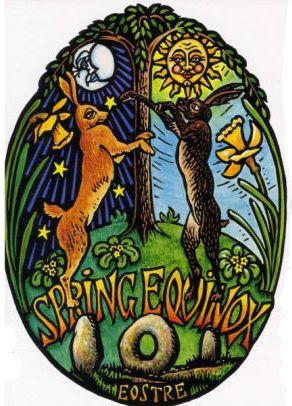Other Names: Spring Equinox, Eostre
Date: March 21 (there about)
Celebration of: The God and Goddess begin their courtship
Related Holiday: Easter
Colors: Light Green
Symbols: Spring flowers
Notes: Light overtakes the dark. Rebirth of life. Contemplate new beginnings and fresh ideas. Serious mediation on your hopes and dreams for the coming year. Solar festival of fire, light, and fertility.
OSTARA, (say Os-Tah-Rah) the Spring Equinox, derives it name from the Goddess Eostre. The Earth is now clearly awakened from her slumber. The day and night are equal but the light is gaining; life is gaining in momentum. This is a time of feasting and celebration. There is a sense of energy and promise personified by the beauty, strength, and freedom of the young virgin Goddess. This is when the clover appears in the fields, a symbol of the rebirth of the Maiden aspect of the Triple Goddess. Significant symbols are the lamb, the hare, and the egg, all universal archetypes of fertility, renewal, and new life, and they are all sacred to Her; the decorating of the eggs with sacred symbols.
The Vernal Equinox
by Mike Nichols
http://www.witchessabbats.com/
Now comes the vernal equinox, and the season of spring reaches its apex, halfway through its journey from Candlemas to Beltane. Once again, night and day stand in perfect balance, with the powers of light on the ascendancy. The God of Light now wins a victory over his twin, the God of Darkness. In The Mabinogion myth reconstruction that I have proposed, this is the day on which the restored Llew takes his vengeance on Goronwy by piercing him with the sunlight spear. For Llew was restored/reborn at the winter solstice and is now well/old enough to vanquish his rival/twin and mate with his lover/ mother. And the Great Mother Goddess, who has returned to her Virgin aspect at Candlemas, welcomes the young Sun God’s embraces and conceives a child. The child will be born nine months from now, at the next winter solstice. And so the cycle closes at last.
We think that the customs surrounding the celebration of the spring equinox were imported from Mediterranean lands, although there can be no doubt that the first inhabitants of the British Isles observed it, as evidence from megalithic sites shows. But it was certainly more popular to the south, where people celebrated the holiday as New Year’s Day, and claimed it as the first day of the first sign of the zodiac, Aries. However you look at it, it is certainly a time of new beginnings, as a simple glance at nature will prove.
In the Roman Catholic Church, there are two holidays that get mixed up with the vernal equinox. The first, occurring on the fixed calendar day of March 25 in the old liturgical calendar, is called the Feast of the Annunciation of the Blessed Virgin Mary (or B.V.M., as she was typically abbreviated in Catholic missals).Annunciation means an “announcement”. This is the day that the archangel Gabriel announced to Mary that she was “in the family way”. Naturally, this had to be announced since Mary, being still a virgin, would have no other means of knowing it. (Quit scoffing, O ye of little faith!) Why did the church pick the vernal equinox for the commemoration of this event? Because it was necessary to have Mary conceive the child Jesus a full nine months before his birth at the winter solstice (i.e., Christmas, celebrated on the fixed calendar date of December 25). Mary’s pregnancy would take the natural nine months to complete, even if the conception was a bit unorthodox.
As mentioned before, the older Pagan equivalent of this scene focuses on the joyous process of natural conception, when the young Virgin Goddess (in this case, “virgin” in the original sense of meaning “unmarried”) mates with the young solar God, who has just displaced his rival. This is probably not their first mating, however. In the mythical sense, the couple may have been lovers since Candlemas, when the young God reached puberty. But the young Goddess was recently a mother (at the winter solstice) and is probably still nursing her new child. Therefore, conception is naturally delayed for six weeks or so and, despite earlier matings with the God, she does not conceive until (surprise!) the vernal equinox. This may also be their handfasting, a sacred marriage between God and Goddess called a hierogamy, the ultimate Great Rite. Probably the nicest study of this theme occurs in M. Esther Harding’s book, Woman’s Mysteries. Probably the nicest description of it occurs in Marion Zimmer Bradley’s The Mists of Avalon, in the scene where Morgan and Arthur assume the sacred roles. (Bradley follows the British custom of transferring the episode to Beltane, when the climate is more suited to its outdoor celebration.)
The other Christian holiday that gets mixed up in this is Easter. Easter, too, celebrates the victory of a God of light (Jesus) over darkness (death), so it makes sense to place it at this season. Ironically, the name “Easter” was taken from the name of a Teutonic lunar Goddess, Eostre (from whence we also get the name of the female hormone, estrogen). Her chief symbols were the bunny (both for fertility and because her worshippers saw a hare in the full moon) and the egg (symbolic of the Cosmic Egg of Creation), images that Christians have been hard pressed to explain. Her holiday, the Eostara, was held on the vernal equinox full moon. Of course, the church doesn’t celebrate full moons, even if they do calculate by them, so they planted their Easter on the following Sunday. Thus, Easter is always the first Sunday, after the first full moon, after the vernal equinox. If you’ve ever wondered why Easter moved all around the calendar, now you know. (By the way, the Catholic Church was so adamant about not incorporating lunar Goddess symbolism that they added a further calculation: if Easter Sunday were to fall on the full moon itself, then Easter was postponed to the following Sunday instead.)
Incidentally, this raises another point: recently, some Pagan traditions began referring to the vernal equinox as ‘Eostara’. Historically, this is incorrect. Eostara is a lunar holiday, honoring a lunar Goddess, at the vernal full moon. Hence, the name “Eostara” is best reserved to the nearest Esbat, rather than the Sabbat itself. How this happened is difficult to say. However, it is notable that some of the same groups misappropriated the term ‘Lady Day’ for Beltane, which left no good folk name for the equinox. Thus, ‘Eostara’ was misappropriated for it, completing a chain reaction of displacement. Needless to say, the old and accepted folk name for the vernal equinox is “Lady Day”. Christians sometimes insist that the title is in honor of Mary and her Annunciation, but Pagans will smile knowingly.
Another mythological motif that must surely arrest our attention at this time of year is that of the descent of the God or Goddess into the Underworld. Perhaps we see this most clearly in the Christian tradition. Beginning with his death on the cross on Good Friday, it is said that Jesus “descended into hell” for the three days that his body lay entombed. But on the third day (that is, Easter Sunday), his body and soul rejoined, he arose from the dead and ascended into heaven. By a strange ‘coincidence’, most ancient Pagan religions speak of the Goddess descending into the Underworld, also for a period of three days.
Why three days? If we remember that we are here dealing with the lunar aspect of the Goddess, the reason should be obvious. As the text of one Book of Shadows gives it, “As the moon waxes and wanes, and walks three nights in darkness, so the Goddess once spent three nights in the Kingdom of Death.” In our modern world, alienated as it is from nature, we tend to mark the time of the new moon (when no moon is visible) as a single date on a calendar. We tend to forget that the moon is also hidden from our view on the day before and the day after our calendar date. But this did not go unnoticed by our ancestors, who always speak of the Goddess’s sojourn into the Land of Death as lasting for three days. Is it any wonder then that we celebrate the next full moon (the Eostara) as the return of the Goddess from chthonic regions?
Naturally, this is the season to celebrate the victory of life over death, as any nature lover will affirm. And the Christian religion was not misguided by celebrating Christ’s victory over death at this same season. Nor is Christ the only solar hero to journey into the Underworld. King Arthur, for example, does the same thing when he sets sail in his magical ship, Prydwen, to bring back precious gifts (i.e., the gifts of life) from the Land of the Dead, as we are told in The Mabinogi. Welsh triads allude to Gwydion and Amaethon doing much the same thing. In fact, this theme is so universal that mythologists refer to it by a common phrase, “the harrowing of hell”.
However, one might conjecture that the descent into hell, or the Land of the Dead, was originally accomplished, not by a solar male Deity, but by a lunar female Deity. It is Nature herself who, in spring, returns from the Underworld with her gift of abundant life. Solar heroes may have laid claim to this theme much later. The very fact that we are dealing with a three-day period of absence should tell us we are dealing with a lunar, not solar, theme. (Although one must make exception for those occasional male lunar deities, such as the Assyrian God, Sin.) At any rate, one of the nicest modern renditions of the harrowing of hell appears in many Books of Shadows as “The Descent of the Goddess”. Lady Day may be especially appropriate for the celebration of this theme, whether by storytelling, reading, or dramatic reenactment.
For modern Witches, Lady Day is one of the Lesser Sabbats or Low Holidays of the year, one of the four quarter days. And what date will Witches choose to celebrate? They may choose the traditional folk fixed date of March 25, starting on its eve. Or they may choose the actual equinox point, when the sun crosses the equator and enters the astrological sign of Aries.
Document Copyright © 1983 – 2009 by Mike Nichols.
Text editing courtesy of Acorn Guild Press.
Website redesign by Bengalhome Internet Services, © 2009
Permission is given to re-publish this document only as long as no information is lost or changed, credit is given to the author, and it is provided or used without cost to others.
This notice represents an exception to the copyright notice found in theAcorn Guild Press edition of The Witches' Sabbats and applies only to the text as given above.
Other uses of this document must be approved in writing by Mike Nichols.

